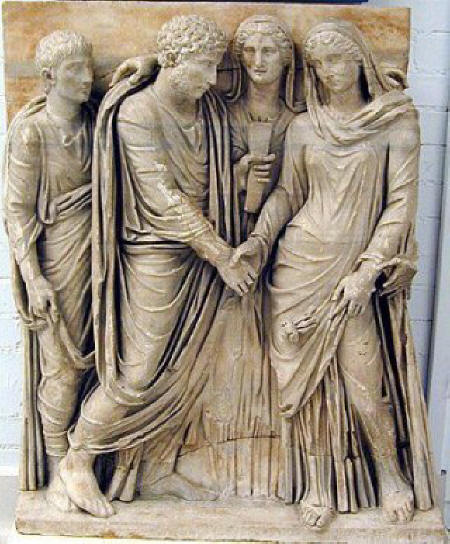|
|
|
|
|
| |
|
|
|

Young aristocratic girl.
Marble Bust. 2nd c AD. Palatine Museum,
Rome. Perhaps she is thinking of her future marriage??
Highlights
* Roman marriage was arranged by the families. Marriage was
a strategic weapon to enhance the family's political and social
standing.
* The purpose of marriage was to produce children. All women were
expected to be married, or remarried.
* The father
by law had to provide a dowry for the daughter.
* In a first marriage, females married around the age of 20 to a male
around the age of 30. |
|
Women and Roman Marriage
Marriage was a private affair, arranged by the heads of families.
For the elite, the name of the game was political power for the family, marriage
a strategic weapon.
Love, not to mention physical pleasure, were mere trifles.
In early Rome, girls as young as 12 had to accept the mates
chosen for them by their families, with the marriage consummated
some years later.
Young
women were married off around the age of 20 to a man
approximately 30
years old.
Julia,
Caesar's beloved only daughter, was married off by him while in
her mid-teens to Pompey, age 44, and six years older than his new father-in-law.
|
|
|
|
|
|
|
|
|
|
|
|
|
The Roman Marriage Ceremony
The bride wore a deep yellow or
flame-colored veil. Her long hair would be arranged in plaits and bound by
fillets in a show of modesty.
The marriage contract was signed and
sealed at the ceremony itself.
The bride and bridegroom clasped hands in a show of trust and respect.
After the ceremony:
feasting at the bride's home
When the
feast was over, the bride and her attendants moved in a torchlit procession
to the bridegroom's house.The bridegroom
The groom
received the bride with
water and fire as symbols of her belonging to his household.
The bridesmaids
They, not the bridegroom, lifted her over the
threshold.
Their role was to
make sure the bride did not trip, a
bad omen.
|
|

The marriage ceremony,
sealed by the
contract in the bridegroom's left hand. Marble sarcophagus, 2nd
AD. The British Museum.
Legally the wife/daughter never left the family kinship group she was
born in. She was always partly in her husband's camp and partly in her
father's. |
|
|
|
|
|
|
|
|
A Roman bride's dowry
A Roman father legally had to provide a
dowry for a daughter. Otherwise, she could never be married. Unmarried
elite females upended Rome's goal of producing legitimate children to
carry on Roman power and its cultural values.
The contract stated the size of the
dowry and other conditions. Dowry amounts became standardized over time.
In comparison with later European societies, they were not particularly large,
perhaps one year's worth of family income.
A Roman bride's inheritance
Her father (and mother) usually left
her, along with the male children, an inheritance. It could be money,
farmland, other real estate, and jewels.
What else might a family do for its daughter?
A father or a mother could give their married daughter an
allowance.
In the end, a spot of freedom:
All three together--the dowry, the allowance, and the future
inheritance--could give the daughter a degree of freedom
from her husband's absolute control.
|
|
An Unmarried Roman woman?
Nope. Roman society had no place, socially or legally, for a never-married, independent single woman of child-bearing
age.
Only the Vestal Virgins, chosen between ages 6 and 10 and required to remain virginal for 30 years, could be single.
On June 9 of
each year, a married woman was allowed into the forbidden parts of the
shrine of Vesta.
Vesta was the goddess of the hearth and home, and
her shrine was guarded by the
Vestal Virgins. The woman would make offerings to Vesta to increase her
chances of bearing a child.
The Emperor Augustus needed more children by the elite to continue
the Roman state. Under his decrees, even a widow or a divorced woman under the age of 50
was to remarry within a certain timeframe so that she could bear
children. If she did not, she could not receive her inheritance or
attend public games.
Remarriage was not easy. In the ancient world, life was very
short-lived. Many, perhaps most, women over the age of 30 had lost
their (considerably older) first husbands to death by disease or
military action.
Augustus' wishes went
up in smoke.
|
|
|
|
|
|
Updated 04-August-2015. You may contact me, Nancy
Padgett, at
NJPadgett@gmail.com |
|
|
|
|